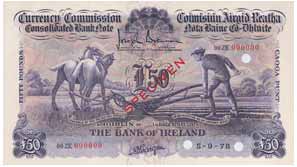
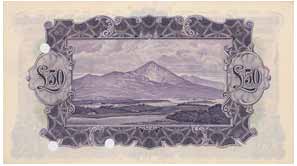

The Central Bank of Ireland Archive was opened to public access in 2017. It has provided considerable new source material on the Consolidated Bank Notes. This is referenced as CBIAR in the text.
There are no examples of issued Ploughman £50 notes outstanding. The last example was remitted in the 1960s [CBIAR]. Examples of issued Munster and Leinster Bank £50 Ploughman notes were retained by the Central bank of Ireland in is archives.
The only examples of Ploughman £50 notes available to collectors are two types of specimen notes. All examples of Ploughman specimen notes which have been seen were printed for the Bank of Ireland.
Official Currency Commission Specimen £50 Pound Ploughman notes were printed in the correct colours in 1929 on watermarked paper with the Bank of Ireland heading. These specimen notes are seldom offered.
De La Rue Ploughman specimens printed in non-standard colours on non-watermarked paper are also available as examples of the design. These specimen notes tend to be found in De La Rue specimen books, or as loose notes with mounting glue on the reverse, having been removed from such books. The De La Rue specimens are more commonly offered.
The Ploughman Scan Survey is a detailed recording of the numbers and grades of the surviving Ploughman currency notes which has been underway for over 15 years which has lead to a solid data set of well over 3,000 notes recorded. The survey also also includes a record of all Ploughman £50 note specimens which have been seen.
Information on the numbers of surviving Ploughman Fifty Pound note specimens, both Currency Commission and De La Rue specimens is updated periodically in the Ploughman Note Population Report.
Illustrated below is a standard issue Consolidated Bank Note £50 specimen, printed on watermarked paper.
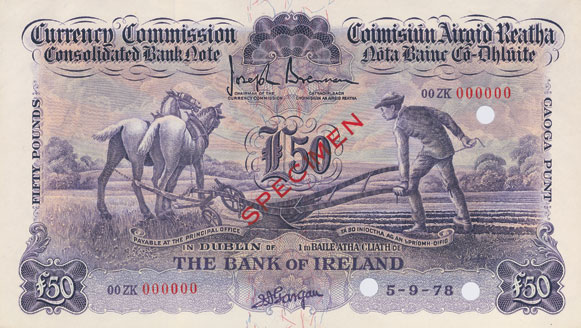
![]()

The Consolidated banknotes were designed by artist Dermod O'Brien (1865-1945) [2.].
The Fifty Pound Consolidated Bank Note is primarily purple in colour, with a beige underprint.
The purple colour of the Fifty Pound note was similar to the colour used on the 'Lady Lavery' series 50 Pound Legal Tender Notes which were first issued in 1928, shortly before the Ploughman notes.
All the text on the face of the Ploughman 50 note note is bilingual, in English on the left side and in Irish on the right.
The title of the Issuing Authority is across the top of the note in an ornate typeface: 'Currency Commission Consolidated Bank Note', 'Coimisiún Airgid Reatha Nóta Bainc Có-Dhlúite'.
The main signature, Joseph Brennan [3.], is printed at the top centre, with his title below it in small letters, 'Chairman of the Currency Commission', 'Cathaoirleach Choimisiúin an Airgid Reatha'.
The denomination in words is printed discretely sideways on either side, 'Fifty Pounds' on the left, 'Caoga Punt' on the right side.
In smaller text at the bottom centre of the note is printed 'Payable at the Principle Office in Dublin of', 'Tá so iníoctha ag an bPríomh-Oifig i mBaile Átha Cliath de'.
The name of the issuing bank, one of the eight Associated Banks which had the right to issue Consolidated Bank Notes, was printed below the 'payable at' text in a later printing which was added along with a prefix which corresponded to the bank. The signatory of the bank was also added under the bank title.
Apart from the official specimen notes in purple, examples of the Ploughman Fifty Pound notes are known as De La Rue printers specimens in blue, and also as proofs and colour trials without the bank title, which were printed in various colours.
Illustrated below is an example of a De La Rue Ploughman 50 Pound specimen, Bank of Ireland, printed in blue.

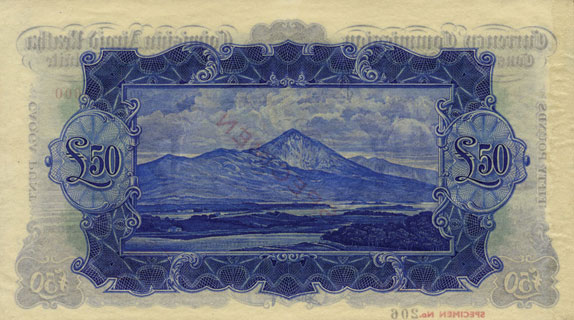

Apart from the official specimen notes in purple, examples of the Ploughman Fifty Pound notes are known as De La Rue printers specimens in blue, and also as proofs without the bank title in various colours
The reverse of the Ploughman 50 Pound note is printed entirely in purple ink, and features a panoramic view of Croagh Patrick mountain.

A view of Croagh Patrick from a similar angle to how it appears on the reverse of the Ploughman 50 Pound note. [4. Image copyright: Bart Horeman 1989. Image source: https://commons.wikimedia.org/wiki/File:Croagh_Patrick,_the_saddle_on_the_western_flanks_-_geograph.org.uk_-_605872.jpg]
The dimensions of each denomination of the Consolidated Bank Notes are the same as those of the corresponding Legal Tender Note. The Ploughman 50 Pound note dimensions are 203 x 114 mm, and can vary by a millimetre or so in either dimension.
Below is illustrated an example of the first date of a Ploughman Fifty Pound note of the Munster and Leinster Bank. 6.5.29 was the only date for the Fifty Pound notes, apart from a second printing of Bank of Ireland £50 notes dated 3.11.30.

The Ploughman 50 Pound notes were printed in several passes. Initially, a multicolored underprint was printed, followed by the top printing layer in purple ink of raised intaglio printing.
The title of the Issuing Authority text 'Currency Commission Consolidated Bank Note', 'Coimisiún Airgid Reatha Nóta Bainc Có-Dhlúite' and the signature 'Joseph Brennan' are printed in raised intaglio print. This print can easily be felt raised on the surface of the note.
In addition to the intaglio printing, all Ploughman notes had a strip of multicolored fibers embedded in the paper which ran down the centre of each note.
This was a common security feature of the era which was used on banknotes of some other countries such as China. The distribution of the watermarks and fibre strip are visible in the mock-up, pictured below.
The Ploughman banknotes were printed by Thomas De La Rue Limited on watermarked paper which was manufactured by Portals Limited.
There are four watermarks on the Consolidated One Pound note, one in each corner.
It was considered that a watermark in centre of the note might be difficult to see, as can be the case with the watermark of the letters 'LTN' in the centre of the legal tender notes.
Viewed from the face of the note, the watermarks on the Ploughman 50 Pound note are a harp on the left, the letters 'CBN' (Consolidated Bank Note) on the right, the letters 'CBN' on the bottom left, and a shamrock on the bottom right. The watermarks on the £50 note are a design common across the £20, £50, and £100 denominations.
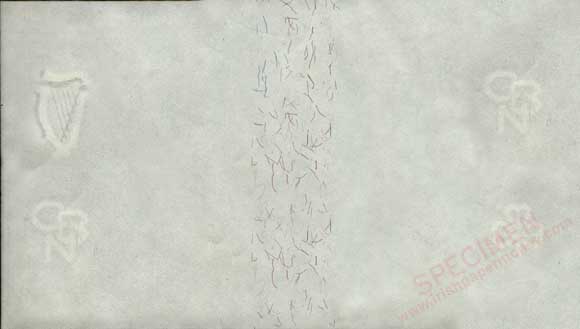
A mock-up of the watermarked paper for the Ploughman higher denomination notes illustrates the four watermarks as they appear on the Ploughman Fifty Pound note when viewed from the face side

The four individual watermarks on the Fifty Pound Ploughman are easily visible when the note is viewed from the reverse side
With less than a thousand notes printed between all the banks, very few £50 Consolidated Bank Notes entered circulation during the lifetime of the note issue, and the denomination was probably not needed at all.
The lowest three denominations of Ploughman notes circulated in modest quantities in the Irish Free State era alongside the Legal Tender Notes. The notes continued to be accepted in occasional circulation up to the 1960s, with isolated £50 notes also turning up.
Currency Commission records show that the £50 denomination consistently had the smallest circulation of the Consolidated notes. The £50 also had the smallest issue, with just four banks opting to issue the notes. Only Bank of Ireland, Munster and Leinster Bank, Royal Bank of Ireland and Ulster Bank issued £50 notes.
Ploughman £50 notes by bank which are known to have been printed are detailed following. This is taken from Central Bank records [CBIAR].
Bank of Ireland: 6.5.29, 01BY 000001 – 01BY 000200; 3.11.30, 01BY 000201 – 01BY 000250.
Munster and Leinster Bank: 6.5.29, 01MY 000001 – 01MY 000100.
Royal Bank of Ireland: 6.5.29, 01RY 000001 – 01RY 000050.
Ulster Bank: 6.5.29, 01UY 000001.
Consolidated Bank Notes ceased production after the Currency Commission Ireland was wound up and replaced by the Central Bank of Ireland.
It appears from records that there was only one print run of Ploughman 50 Pound notes, with partly printed notes being stored for later use [CBIAR].
Most of the printage of £50 notes appears to have been destroyed unissued [CBIAR].
On 31 December 1953 all issues ceased, and the Central Bank of Ireland became the sole issuer of banknotes in Ireland.
All issued Ploughman £50 notes have been redeemed. However, several varieties of Ploughman 50 Pound specimen notes are known, and are available to collectors.
Although issued examples of Ploughman £1, £5 and £10 notes can easily be obtained, examples of higher denomination specimen notes are quite rare.
The Consolidated Bank Note Population Report from the Ploughman Scan Survey, records the known examples of Ploughman 50 Pound specimen notes.
There were four signature varieties for the £50 Consolidated Bank Note, corresponding to the four banks which issued the denomination. Of these, only examples of the Munster and Leinster Bank with Gubbins signature are known to have survived, in the Central Bank archives. Examples of the Bank of Ireland £50 notes with Gargan signature have survuved and are available as specimens only.
Bank of Ireland: Gargan 1929, 1930.
Hibernian Bank: .
Munster & Leinster Bank: Gubbins 1929.
National Bank: .
Northern Bank: .
Provincial Bank of Ireland: .
Royal Bank of Ireland: Stanley 1929.
Ulster Bank: Patton 1929.
References [Last retrieved 14.08.24]
1. Central Bank of Ireland Archives.
2. Dermod O'Brien (1865-1945) <https://www.dib.ie/biography/obrien-dermod-a6460p>
3. Joseph Brennan (1887-1976) <https://www.dib.ie/biography/brennan-joseph-a0938>
4. Croagh Patrick. Image copyright: Bart Horeman 1989. Image source: < https://commons.wikimedia.org/wiki/File:Croagh_Patrick,_the_saddle_on_the_western_flanks_-_geograph.org.uk_-_605872.jpg > reproduced under the Creative Commons Attribution-Share Alike 2.0 Generic license https://creativecommons.org/licenses/by-sa/2.0/deed.en.
1 Pound Ploughman
5 Pounds Ploughman
10 Pounds Ploughman
20 Pounds Ploughman
50 Pounds Ploughman
100 Pounds Ploughman
Irish Ten Shilling Notes
1 Pound Note Lady Lavery
5 Pounds Lady Lavery
10 Pounds Lady Lavery
20 Pounds Lady Lavery
50 Pounds Lady Lavery
100 Pounds Lady Lavery
1 Pound Note, Queen Medb
5 Pound Note, John Scotus Eriugena
10 Pound Note, Jonathan Swift
20 Pound Note, W. B. Yeats
50 Pound Note, Turlough O'Carolan
100 Pound Note, Grace O'Malley
5 Pound Note, Sister Catherine McAuley
10 Pound Note, James Joyce
20 Pound Note, Daniel O'Connell
50 Pound Note, Douglas Hyde
100 Pound Note, Charles Stewart Parnell
Northen Ireland Polymer notes
Bank of Ireland Polymer Notes
Danske Bank Polymer Notes
Ulster Bank Polymer Notes
Special Sections and Articles
The Transition of Irish Currency, Irish banknotes 1918–1928
The Partition of Irish Currency, Irish banknotes 1928–1930
Banknote Design Evolution 1824 to 1916
Irish Three Pound Notes
Contemporary Forgeries of Early Irish Banknotes, ca1800-1930
Limerick Soviet Notes
Irish World War 2 Banknote Issues
Low Number Irish Banknotes
Irish Joint Stock Banks of Note Issue from 1783
Irish Legal Tender Note Specimens
Ploughman Scan Survey (PSS)
![]() Stable version. Last update 24.09.24.
Stable version. Last update 24.09.24.